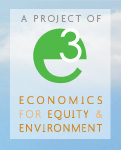Cross-posted on the Triple Crisis blog
Some of the best things in life are free. Unfortunately, so are some of the worst.
When polluters dump poisons into our air and water, they do it for free. This means they have no incentive to curb emissions. It also means that our air and water effectively belong to them, not to those who breathe the air and drink the water.
Regulation
Environmental regulations limit what polluters can lawfully discharge into our air and water. The damage control they provide is of great value. The U.S. Environmental Protection Agency estimates that from 1970 to 1990 alone the Clean Air Act saved more than three million lives. Critics can argue about whether the regulations should be tighter or lighter, but no sensible person would advocate jettisoning them altogether.
But while regulation does much to protect public health and the environment, it doesn’t stop free pollution. Within the regulatory envelope, pollution that is legal is free. Firms are supposed to follow the rules, but they have no incentive to cut pollution beyond the mandated limits.
Cap-and-Giveaway-and-Trade
In 1990 the U.S. government tried something new: it required electric power companies to have permits for their emissions of sulfur dioxide, a health hazard and source of acid rain. Each permit allows the polluter to discharge one ton of SO2 into the air, with the cap on the total number of permits being ratcheted down over time.
To win political buy-in from the companies, Congress gave them free permits based on their historic emissions. Companies can then sell permits and buy them from each other. Permit trading would be redundant if they were auctioned rather than handed out free, but the giveaways made trading a necessary part of the system.
This is called “cap and trade.” A more accurate name would be cap-and-giveaway-and-trade. The policy solves the incentive problem, because companies now can make money by reducing pollution and their need for permits, and profit by finding new and cheaper ways to do so. Economists have lauded the outcome as a great success because SO2 emissions were cut in half in the span of a decade at a low cost.
But as a solution to the property rights problem, cap-and-giveaway-and-trade is perverse. Free permits to polluters ratify their appropriation of our air and water. The permits become another cost of doing business, passed along to consumers via higher electricity prices. The companies then pocket the money as windfall profits.
Cap-and-Dividend
Attempts to pass a cap-and-trade climate bill in the U.S. failed this year for the third time. Opponents charged that carbon cap-and-trade would amount to “the largest excise tax in history.” Proponents countered that the cost to the average American family would only be “about a postage stamp a day.”
This dispute hinged on confusion – inadvertent or deliberate – between the cost of preventing pollution and the value of permits for pollution that is not prevented. The postage stamp number, based on a 2009 Congressional Budget Office report, refers to the cost of cutting carbon emissions to stay within the cap. This cost is relatively modest because there are many low-cost ways to improve energy efficiency.
The value of permits – the quantity of permitted emissions multiplied by the permit price – is a much bigger number. To see the difference, click here. This represents the lion’s share of price increases that consumers would see at the gas pump and in their electricity bills.
Whether this permit value is really a “tax” depends on what happens to the money. In cap-and-giveaway-and-trade, it’s not a tax because it goes to companies as windfall profits. If the permits are auctioned instead, and the government keeps the money as in the Regional Greenhouse Gas Initiative in the northeastern U.S. states, it is true that it’s like a tax.
There is an alternative to windfall profits and taxes. A cap-and-dividend policy would return the money directly to the public as equal dividends for every woman, man and child in the country. This is the approach taken by U.S. Senators Maria Cantwell (D-WA) and Susan Collins (R-ME) in the climate bill that they introduced a year ago and plan to reintroduce with additional co-sponsors in the next session of Congress.
Cap-and-dividend is founded on the principle that the air and water belong to all of us. The policy has several attractions. It provides incentives to cut pollution and drives investment in clean technologies. It protects working families from the impact of price increases resulting from permits on their purchasing power. Most important, by delinking environmental policy from the contentious issue of taxes it just might be a politically viable way to stop the travesty of free pollution.

